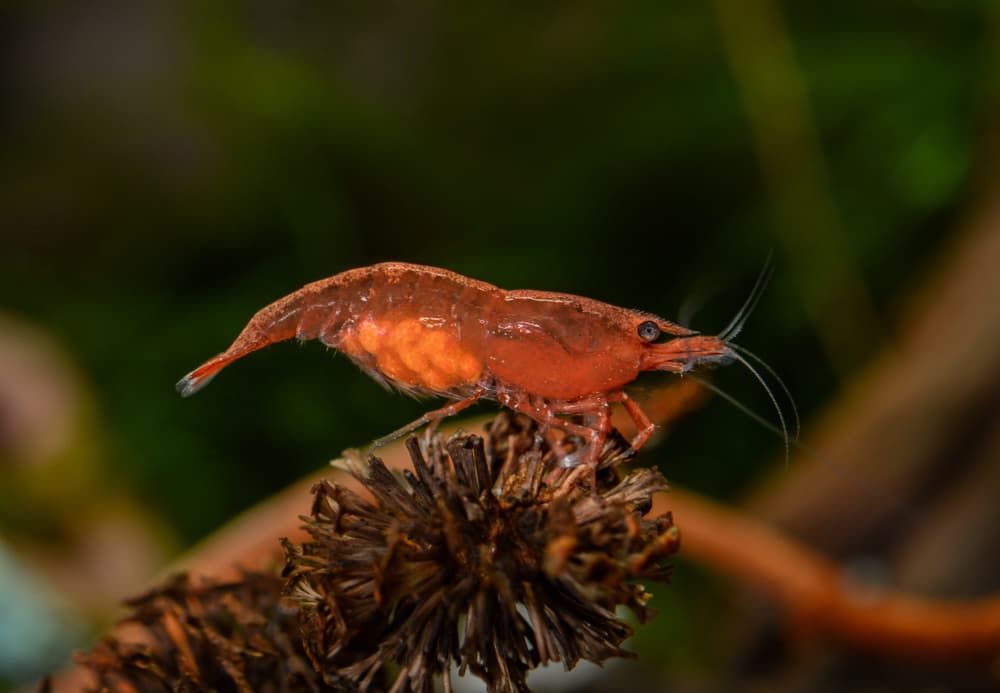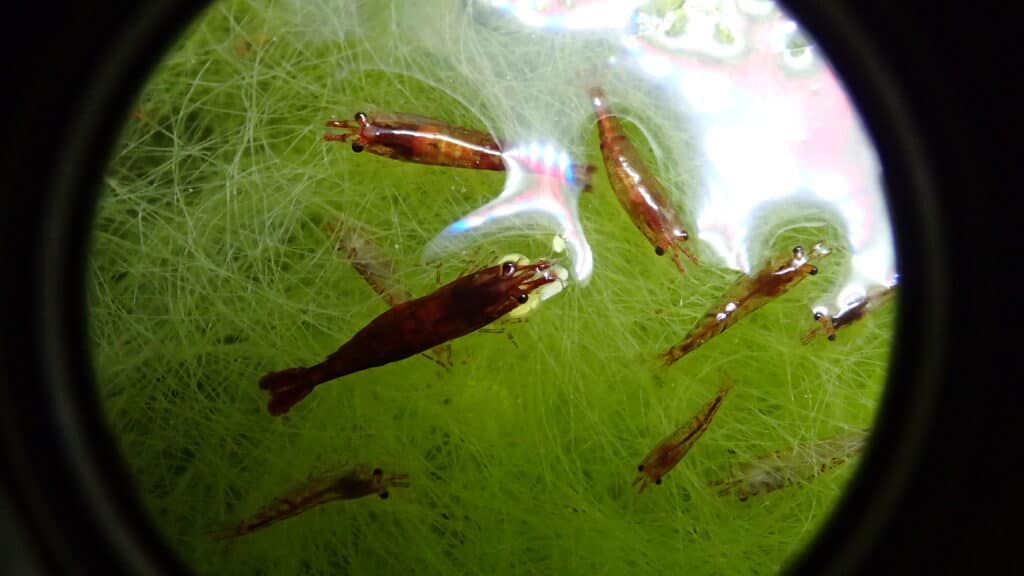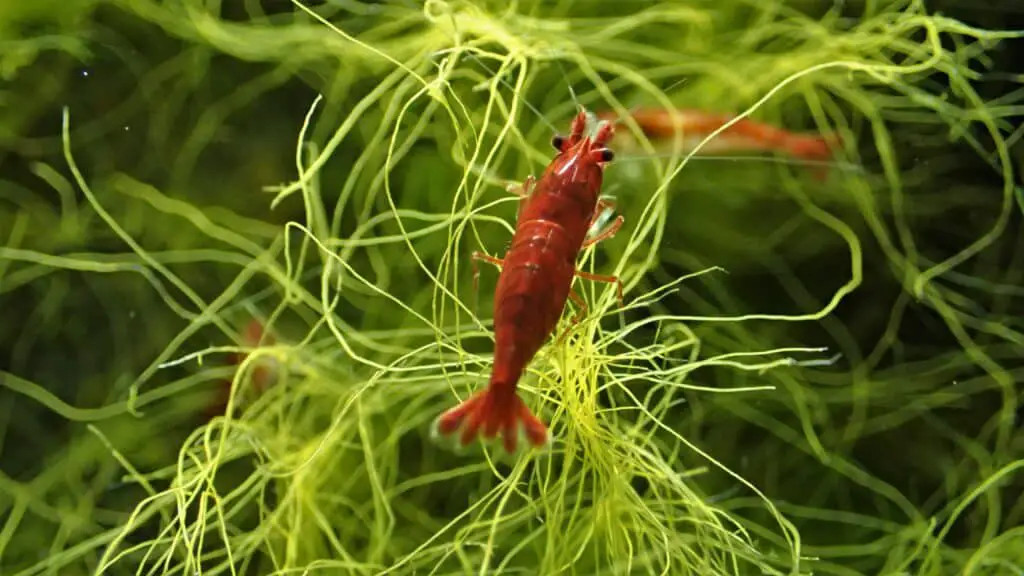The best beginner shrimp are often the Red Cherry Shrimp (Neocaridina davidi). They’re hardy, adaptable, and breed quickly. A vibrant addition to any freshwater aquarium, these little crustaceans can help acclimate a new shrimp keeper to their unique care needs.
Hello fellow aquatic enthusiasts! I’m a devoted shrimp keeper, and I’ve been keeping these little aquatic gems for more than two decades. I remember my first encounter with shrimp-keeping was with a small group of Red Cherry Shrimp. Their vibrancy and activity level had me hooked in no time! Over the years, I’ve ventured into different shrimp species, from the beautiful Crystal Reds to the elusive Sulawesi Shrimp.
But, let me take you back to where it all began. In this article, we’ll delve into why the Red Cherry Shrimp is a great choice for beginners. We’ll touch on their hardiness, breeding habits, and their role in the aquatic ecosystem. Get ready to dip your toes into the fascinating world of shrimp-keeping!
Characteristics of Red Cherry Shrimp
The Red Cherry Shrimp (Neocaridina davidi) are quite the eye-catchers with their brilliant red coloration. In the shrimp-keeping world, we affectionately refer to them as the ‘living jewels’ of freshwater aquariums. Their size ranges from 1 to 1.5 inches, making them perfect for even the smallest of tanks.
Now, let’s talk colors. Female Red Cherry Shrimps are more vibrantly colored than their male counterparts – a stunning cherry red that is hard to miss. Males, on the other hand, exhibit a slightly paler hue. Interestingly, the intensity of their color can depend on their environment, diet, and overall health. A well-cared-for Red Cherry Shrimp can truly live up to its name, gleaming like a tiny ruby in the tank.
Red Cherry Shrimp are also incredibly active. They love to scuttle around the aquarium, foraging for algae and detritus. The sight of them constantly at work, cleaning up the tank while flashing their bright red bodies, is a delightful spectacle. They are largely non-aggressive and cohabit peacefully with similarly gentle species. However, due to their small size, they can become easy prey for larger, predatory fish.
One more thing that makes Red Cherry Shrimp so interesting is their exoskeleton. Like all shrimp, they molt regularly as they grow, shedding their old shell to make way for a new one. If you spot an empty shell in the tank, don’t panic – it’s simply a sign of a growing shrimp.
Understanding the characteristics of Red Cherry Shrimp not only highlights their visual appeal but also helps you appreciate their important role in maintaining the health of your aquarium. So, as you set out on your shrimp-keeping adventure, remember: these aren’t just pretty faces. They are hard-working members of your aquatic team.

Environment for Red Cherry Shrimp
Crafting the ideal environment for Red Cherry Shrimp is an exercise in understanding their natural habitat and replicating it to the best of our abilities in an aquarium setting. Originating from freshwater streams in Taiwan, these crustaceans are accustomed to environments with gentle flow, lots of hiding spots, and a rich source of biofilm to munch on.
A well-structured aquarium for Red Cherry Shrimp should ideally be at least 5 gallons in size. They are social creatures and enjoy being part of a small group. Hence, a slightly larger tank would allow for the comfortable accommodation of about ten shrimp. This said, these aquatic cherries can indeed thrive even in nano tanks due to their small size.
Water parameters are crucial when setting up your tank. Red Cherry Shrimp prefer water temperatures ranging from 20 to 28 degrees Celsius (68 to 82 degrees Fahrenheit). They can tolerate a pH range of 6.5 to 8.0, but somewhere around 7.0, which is neutral, is often best.
One feature that will make your shrimp particularly happy is the presence of live plants. Plants like Java Moss or Anubias not only offer ample hiding spots but also provide biofilm and algae, a dietary staple for the shrimp. Add a piece of driftwood or two, and you’ve created a shrimp haven that replicates their natural habitat while also being visually appealing for the viewer.
The substrate you choose can also contribute to the aesthetic and health of your aquarium. Dark-colored substrate can make the vibrant color of the Red Cherry Shrimp pop. More importantly, substrates like gravel or sand can house beneficial bacteria and offer a good grazing surface for the shrimp.
Remember, an ideal environment isn’t just about the physical factors. Peaceful tank mates are a must for these non-aggressive creatures. Smaller, non-predatory fish or other dwarf shrimp species often make excellent companions.
Creating a suitable environment for your Red Cherry Shrimp can seem like a challenging task, but it is also a rewarding one. When you see your shrimp healthy and happy in the little world you’ve created for them, you’ll know it’s worth the effort!

Breeding Red Cherry Shrimp
Red Cherry Shrimp are prolific breeders, which is a trait that has contributed to their popularity among beginners. Their breeding habits are relatively straightforward and involve little intervention from the keeper, making it a gratifying experience even for those new to the hobby.
The shrimp’s reproductive cycle begins when the female molts, a process where she sheds her old exoskeleton to accommodate growth. This molting process also signifies that the female is ready to mate, and it usually triggers a bit of a frenzy among the males. Once mating occurs, the female carries the fertilized eggs in her swimmerets, located beneath her body. This stage is known as being “berried” due to the resemblance of the egg cluster to a small berry.
Egg incubation lasts for about 30 days, during which the female diligently cares for the eggs, fanning them with her swimmerets to ensure proper oxygenation. You might even notice your berried female less active during this period, preferring quieter and safer parts of the tank.
Once the eggs hatch, the baby shrimp, known as shrimplets, are miniature copies of the adults and are fully independent. They will begin foraging for food immediately, feeding on biofilm and algae in the tank. It’s essential to ensure the aquarium environment is rich in these food sources for the shrimplets to grow and thrive.
One of the delights of keeping Red Cherry Shrimp is observing their breeding habits and witnessing the growth of shrimplets. However, bear in mind that their prolific nature can lead to overpopulation in the tank if not carefully managed. Adjusting feeding amounts and rehoming excess shrimp may be necessary steps to maintain a balanced aquarium ecosystem.
So there you have it! In the shrimp world, life is a cycle of molting, mating, and munching, and these little crustaceans do it with an elegance that’s hard to ignore.

Role of Red Cherry Shrimp in an Aquarium
Red Cherry Shrimp are more than just ornamental additions to your freshwater aquarium. These vibrant little creatures play several crucial roles that contribute to the overall health and balance of your aquatic ecosystem.
Firstly, Red Cherry Shrimp are renowned for their role as efficient cleaners. Their favorite pastime is foraging for food, and they’re not picky eaters. They will happily munch on biofilm, algae, and any uneaten food that might otherwise decay and pollute the tank. This tireless cleaning effort helps keep the water clean and reduces the risk of harmful spikes in nitrate levels.
Another important role of these tiny custodians is as bio-indicators. Changes in a shrimp’s behavior, color, or molting frequency can often indicate changes in water quality. For example, if you notice your Red Cherry Shrimp are less active or their vibrant color seems to be fading, it might be time to check the water parameters. In essence, these shrimp help provide a visual indication of your tank’s overall health.
Additionally, Red Cherry Shrimp contribute to the aesthetic appeal of an aquarium. Their bright color contrasts beautifully with green plants and dark substrates, adding a dash of vivacity to your underwater landscape. Their active nature also brings a sense of dynamism to the aquarium, making it a delight to watch.
Finally, Red Cherry Shrimp can serve as an alternative food source in a community tank. While this might not sound like the most pleasant role, it’s a natural part of the food chain in a balanced ecosystem. However, be mindful of the tank mates you choose to ensure your shrimp aren’t merely a snack for predatory species.
In sum, Red Cherry Shrimp do more than just add beauty to your tank; they are integral members of the aquatic community that work tirelessly to maintain a harmonious and healthy environment.

Challenges of Keeping Red Cherry Shrimp
While Red Cherry Shrimp are known for their hardiness and adaptability, like any other pet, they come with their own set of challenges. Addressing these potential hurdles early on will ensure your journey into shrimp keeping is a smooth one.
One of the primary challenges with keeping Red Cherry Shrimp is maintaining stable water parameters. Shrimp are more sensitive to water conditions than most fish. A sudden change in temperature, pH, or water hardness can stress the shrimp, leading to disease or even death. Regular testing and maintenance of your aquarium water is crucial to avoid such scenarios.
Overpopulation can be another challenge with Red Cherry Shrimp due to their prolific breeding. A sudden population boom can stress the aquarium’s resources and lead to competition for food. Regular culling, which involves selecting and removing less vibrant or weaker shrimp, can help control the population and improve the overall health and color vibrancy of your shrimp colony.
Another potential challenge is choosing appropriate tank mates. While Red Cherry Shrimp are peaceful and sociable, they can easily become a meal for larger, predatory fish. Carefully choosing non-aggressive and similarly sized tank mates can help prevent this unfortunate circumstance.
Lastly, maintaining a balanced diet can be tricky. Red Cherry Shrimp are omnivorous scavengers, and while they eat biofilm and algae, they also need a varied diet to thrive. Overfeeding, however, can lead to poor water quality. Striking the right balance involves providing a mixture of commercial shrimp food, blanched vegetables, and occasional protein sources, all in moderate quantities.
Despite these challenges, the rewards of shrimp keeping – observing their complex behaviors, their breeding rituals, and their essential role in the tank – make it a truly fulfilling hobby. As with any hobby, the key to success lies in understanding and catering to your pet’s needs, and the same goes for these aquatic cherries.

Alternatives to Red Cherry Shrimp for Beginners
While Red Cherry Shrimp are an excellent choice for beginners, there are other species that are equally suited for those just starting their shrimp keeping journey. Let’s explore a few alternatives that you might consider.
The Ghost Shrimp (Palaemonetes paludosus) is an affordable and widely available option. They are larger than the Red Cherry Shrimp, reaching up to 2 inches in length, and are almost transparent, making them quite intriguing to observe. Like Red Cherry Shrimp, Ghost Shrimp are hardy, adaptable, and excellent tank cleaners.
Next up, we have the Amano Shrimp (Caridina multidentata), named after the famous aquascaper Takashi Amano. Amano Shrimp are renowned algae eaters and can tackle even the most stubborn varieties. They are slightly larger than both Red Cherry and Ghost Shrimp and have a unique, semi-transparent body with dotted lines running along their length.
Snowball Shrimp (Neocaridina palmata) are another alternative worth considering. Similar to Red Cherry Shrimp in size and care requirements, Snowball Shrimp are characterized by their pale, almost translucent coloration and the white “snowball-like” eggs that females carry.
Lastly, the Bamboo Shrimp (Atyopsis moluccensis), also known as the Wood Shrimp or Asian Filter Shrimp, is a slightly more advanced option. Bamboo Shrimp are filter feeders, meaning they use fan-like appendages to filter out tiny particles from the water for their nutrition. They are larger and require a slightly more specific setup with a stronger current, but they make a fascinating addition to a beginner’s aquarium due to their unique feeding habits.
Remember, while these alternatives are generally beginner-friendly, each species has its unique needs in terms of tank setup, water parameters, and diet. Regardless of the shrimp species you choose, doing your research beforehand and being attentive to your shrimp’s behavior and health will ensure a satisfying shrimp keeping experience.

Conclusion
Starting your shrimp keeping journey with Red Cherry Shrimp is a brilliant choice. These little crustaceans are hardy, easy to care for, and actively contribute to maintaining your aquarium’s health. Their vibrant color, coupled with their active nature, make them an attractive and entertaining addition to your underwater world.
However, like all aquatic pets, they come with their challenges. From maintaining the right water parameters to ensuring they’re not overpopulating your tank, these tasks require regular attention. But remember, every challenge you overcome is a step towards becoming a more seasoned shrimp keeper.
Also, keep in mind that Red Cherry Shrimp are just one of many beginner-friendly shrimp species. From the ghostly Ghost Shrimp to the industrious Amano Shrimp, there’s a vast world of shrimp to explore.
And finally, as you embark on this exciting journey, remember that the shrimp keeping community is here for you. Whether it’s questions about tank setup, feeding, or dealing with unexpected shrimp behavior, don’t hesitate to reach out. We’re all learning and growing in this hobby together. Happy Shrimp Keeping!
FAQ
Q. Which shrimp is best for beginners?
A. Red Cherry Shrimp are often considered the best shrimp for beginners due to their hardiness, vibrant color, and ease of care.
Q. What’s the easiest shrimp to keep?
A. Both Red Cherry Shrimp and Ghost Shrimp are among the easiest to keep. They are hardy, adaptable, and have relatively straightforward care requirements.
Q. Are shrimp good beginner fish?
A. Shrimp aren’t fish, but they are a good choice for beginners in the aquarium hobby. They are generally low-maintenance, and observing their behavior can be a fascinating introduction to aquatic life.
Q. What is the best shrimp to keep?
A. The “best” shrimp to keep depends on your specific needs and interests. Red Cherry Shrimp are great for beginners, Amano Shrimp are excellent algae eaters, and Bamboo Shrimp are fascinating due to their filter-feeding habits.
Q. Are Cherry shrimp for beginners?
A. Yes, Cherry Shrimp are excellent for beginners. They are hardy, easy to care for, and their bright color makes them a striking addition to any aquarium.
Q. Do shrimp clean fish tanks?
A. Yes, shrimp, including Red Cherry Shrimp, can help clean fish tanks. They eat algae, biofilm, and leftover food, helping to keep the tank clean and the water quality high.
Q. Should I get cherry or ghost shrimp?
A. Both Cherry and Ghost Shrimp are beginner-friendly, but they offer different visual appeal. Cherry Shrimp are brightly colored, while Ghost Shrimp are almost transparent. Choose the one that aligns best with your aesthetic preference and the rest of your tank’s inhabitants.
Q. Can I put shrimp in a new tank?
A. It’s best to wait until a new tank has completed its nitrogen cycle before adding shrimp. This process can take several weeks but ensures that the environment is safe and stable for the shrimp.
Q. What is the hardiest shrimp?
A. Both Red Cherry Shrimp and Ghost Shrimp are known for their hardiness. They can tolerate a range of water conditions and are resistant to many common shrimp diseases, making them excellent choices for those new to shrimp keeping.
